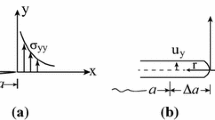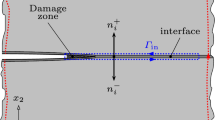Abstract
The virtual crack closure technique makes use of the forces ahead of the crack tip and the displacement jumps on the crack faces directly behind the crack tip to obtain the energy release rates \({{\mathcal {G}}}_I\) and \({\mathcal {G}}_{II}\). The method was initially developed for cracks in linear elastic, homogeneous and isotropic material and for four noded elements. The method was extended to eight noded and quarter-point elements, as well as bimaterial cracks. For bimaterial cracks, it was shown that \({\mathcal {G}}_I\) and \({\mathcal {G}}_{II}\) depend upon the virtual crack extension \(\varDelta a\). Recently, equations were redeveloped for a crack along an interface between two dissimilar linear elastic, homogeneous and isotropic materials. The stress intensity factors were shown to be independent of \(\varDelta a\). For a better approximation of the Irwin crack closure integral, use of many small elements as part of the virtual crack extension was suggested. In this investigation, the equations for an interface crack between two dissimilar linear elastic, homogeneous and transversely isotropic materials are derived. Auxiliary parameters are used to prescribe an optimal number of elements to be included in the virtual crack extension. In addition, in previous papers, use of elements smaller than the interpenetration zone were rejected. In this study, it is shown that these elements may, indeed, be used.








Similar content being viewed by others
References
Abaqus/CAE (2014) Version 6.14. Dassault Systèmes Simulia Corp., Providence, RI, USA
Agrawal A, Karlsson AM (2006) Obtaining mode mixity for a bimaterial interface crack using the virtual crack closure technique. Int J Fract 141:75–98
Banks-Sills L, Boniface V (2000) Fracture mechanics of an interface crack between a special pair of transversely isotropic materials. In: Chuang TJ, Rudnicki JW (eds) Multiscale deformation and fracture in materials and structures. Kluwer Academic Publishers, Amsterdam, pp 183–204
Banks-Sills L, Farkash E (2016) A note on the virtual crack closure technique for a bimaterial interface crack. Int J Fract 201:171–180
Beuth JL (1996) Separation of crack extension modes in orthotropic delamination models. Int J Fract 77:305–321
Boniface V, Banks-Sills L (2002) Stress intensity factors for finite interface cracks between a special pair of transversely isotropic materials. J Appl Mech 69:230–239
Chow WT, Atluri SN (1995) Finite element calculation of stress intensity factors for interfacial crack using virtual crack closure integral. Comput Mech 16:417–425
Freed Y, Banks-Sills L (2005) A through interface crack between a \(\pm 45^{\circ }\) transversely isotropic pair of materials. Int J Fract 133:1–41
Hemanth D, Shivakumar Aradhya KS, Rama Murthy TS, Govinda Raju N (2005) Strain energy release rates for an interface crack in orthotropic media—a finite element investigation. Eng Fract Mech 72:759–772
Irwin GR (1958) Fracture. In: Flugge S (ed) Encyclopedia of physics. Springer, Berlin, pp 551–590 Vol. IV
Lekhnitskii SG (1950, in Russian; 1963, in English) Theory of elasticity of an anisotropic body. Holden-Day, San Francisco, translated by Fern P
Maple 18.00 (2014) Maplesoft, Waterloo Maple Inc, Waterloo
Oneida EK, van der Meulen MCH, Ingraffea AR (2015) Methods for calculating \(G\), \(G_{I}\) and \(G_{II}\) to simulate crack growth in 2D, multiple-material structures. Eng Fract Mech 140:106–126
Raju IS (1987) Calculation of strain-energy release rates with higher order and singular finite elements. Eng Fract Mech 28:251–274
Raju IS, Crews JH Jr, Aminpour MA (1988) Convergence of strain energy release rate components for edge-delaminated composite laminates. Eng Fract Mech 30:383–396
Rice JR (1988) Elastic fracture mechanics concepts for interfacial cracks. J Appl Mech 55:98–103
Rice JR, Sih GC (1965) Plane problems of cracks in dissimilar media. J Appl Mech 32:418–423
Rybicki EF, Kanninen MF (1977) A finite element calculation of stress intensity factors by a modified crack closure integral. Eng Fract Mech 9:931–938
Stroh AN (1958) Dislocations and cracks in anisotropic elasticity. Philos Mag 7:625–646
Sun CT, Jih CJ (1987) On strain energy release rates for interfacial cracks in bi-material media. Eng Fract Mech 28:13–20
Sun CT, Manoharan MG (1989) Strain energy release rates of an interfacial crack between two orthotropic solids. J Compos Mater 23:460–478
Sun CT, Qian W (1997) The use of finite extension strain energy release rates in fracture of interfacial cracks. Int J Solids Struct 34:2595–2609
Toya M (1992) On mode I and mode II energy release rates of an interface crack. Int J Fract 56:345–352
Acknowledgements
We would like to thank Rami Eliasi for his assistance with the finite element analyses.
Author information
Authors and Affiliations
Corresponding author
Rights and permissions
About this article
Cite this article
Farkash, E., Banks-Sills, L. Virtual crack closure technique for an interface crack between two transversely isotropic materials. Int J Fract 205, 189–202 (2017). https://doi.org/10.1007/s10704-017-0190-6
Received:
Accepted:
Published:
Issue Date:
DOI: https://doi.org/10.1007/s10704-017-0190-6




